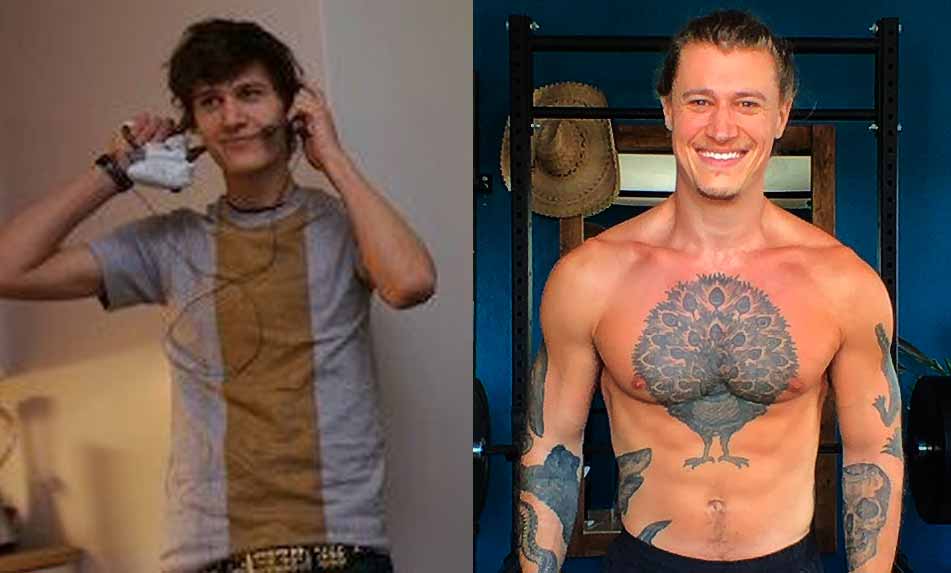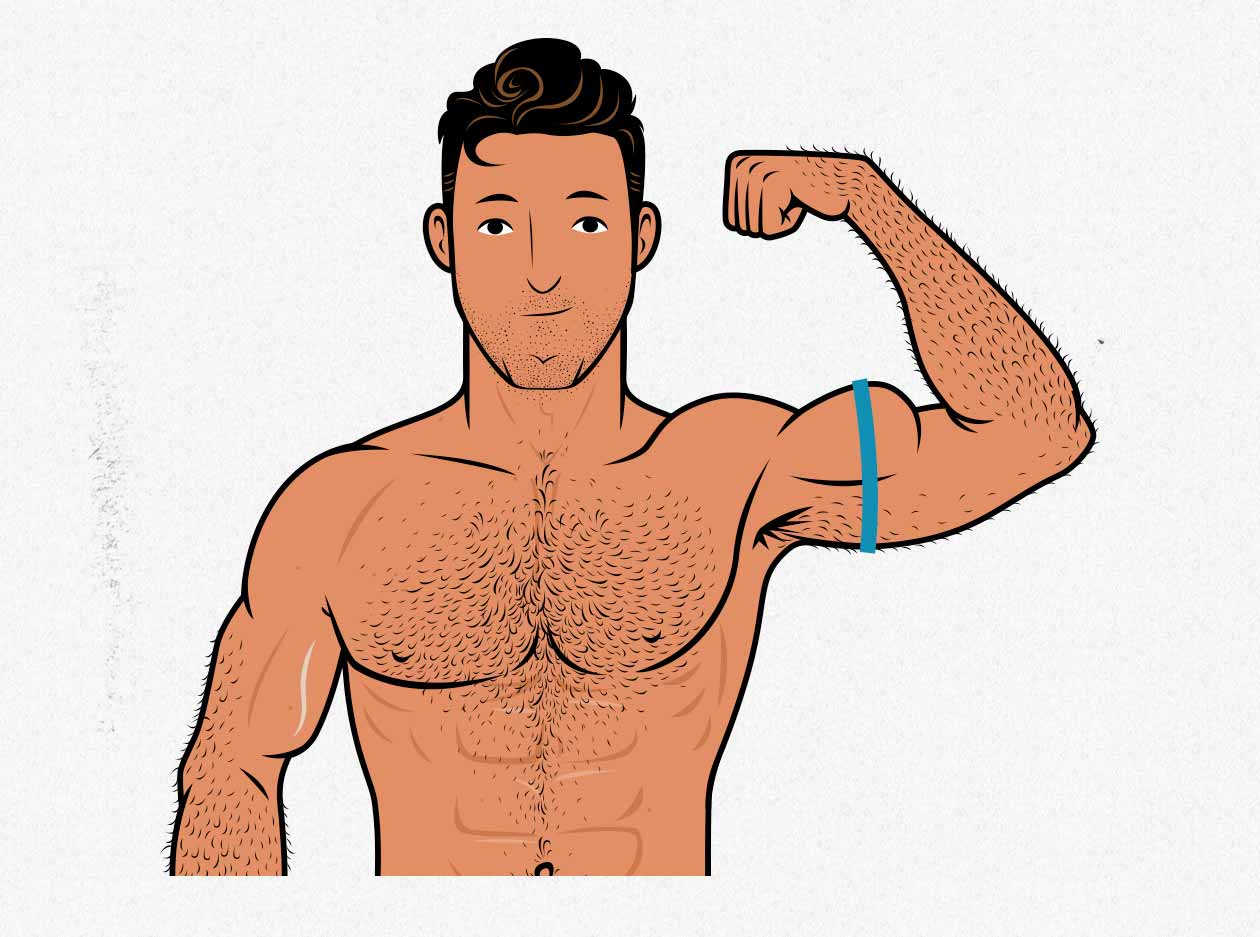
How to Know if You’re Skinny
How can you know if you’re skinny? There are a couple different ways. One definition for skinny is being underweight, so we can calculate your BMI. Another definition for skinny is having small muscles and lanky limbs, so we can look at your body-part measurements to see if you have smaller muscles than the average man.
That gives us two tests:
- Are you underweight?
- Are your muscles smaller than the average man’s?
In either case, we can then help you bulk up so that you’ve got a healthy bodyweight and muscles that look strong because they are strong.

Are You Underweight?
The best place to start is by calculating your body mass index (BMI), which will tell you how much you weigh relative to your height. If your BMI is less than 18.5, you’re underweight, and so you can likely improve your health by gaining weight. Here’s a simple BMI calculator:
I struggled for a long time with being skinny and underweight. A couple of years before founding Bony to Beastly, the most I had ever weighed was 130 pounds at a height of 6’2, giving me a BMI of 16.7—underweight. My doctor recommended that I try to eat more calories to gain weight, but it took me many years of trial and error, successes and regressions, before I finally managed to gain weight in a sustainable way. I just couldn’t fit all of those extra calories in my stomach.

Now I weigh 193 pounds at roughly the same body-fat percentage as when I started. Not only am I no longer underweight, but if I gain another pound, I’ll technically be classified as overweight. Not only that, but I’ve managed to improve all of my indicators of general health, especially my heart health.
My business partners had similar success. Marco went from 150 pounds up to 210 pounds at a height of 6’4, and Jared went from 130 pounds up to 180 pounds at a height of 6′. We then went on to help over 10,000 other skinny people gain weight, including desk workers, doctors, dieticians, and professional athletes. Everyone can do this. It just takes work.
If you’re underweight, a so-called “ectomorph,” there are a few things you can do. The most common recommendations you’ll hear is to eat more frequently, eat foods that are higher in calories, and add in smoothies/shakes. And that’s true—that’s all good advice. But keep in mind that this will help you gain weight, not necessarily lean weight. If you’re trying to gain weight by building muscle, you’ll need to start with resistance training.
Here’s how to gain weight as a skinny guy:
- Why is it So Hard for Skinny Guys to Gain Weight?
- How to Eat Enough Calories to Gain Weight
- The Best Bulking Foods
Do You Have Small Muscles?
There are a number of different body-part measurements we could take, but they aren’t always a great indicator of how big your muscles are. For example, your shoulder circumference is determined by how big your shoulders, upper chest, and upper back muscles are, and you can certainly build broader shoulders, but your bone structure also plays into it. Some skinny guys will have fairly broad shoulders relative to their height and relative to their waists simply because they have longer collarbones.
The simplest way to see if you have smaller muscles than the average man is to measure our upper arm size—our biceps size. Most men will store a bit of fat there, but not enough to dramatically increase their arm size. In fact, according to data collected by the CDC, the average man is 5’8 and 197 pounds, giving him a BMI of 30 (obese), and yet has an upper-arm size of just 13.3 inches.

So, to see if your muscles are smaller than average, you can measure your biceps circumference. To do that, flex your biceps and measure their circumference at the largest point, as shown above. You could also measure your biceps relaxed… but that measurement would be smaller. Fortunately, it’s more common to use flexed biceps measurements when talking about upper-arm size. So the more flattering number is also the correct one.
If your biceps circumference is less than the average man’s—less than 13.3 inches—then it’s a good sign that you have smaller muscles than the average man, and so, in that sense, you could be considered skinny.
Back when I weighed 130 pounds, my flexed biceps measured 10 inches in circumference at their largest point. Now, at 193 pounds, my biceps measure 15.5 inches, meaning that they grew at a rate of about 1 inch per 10 pounds gained overall. In our experience, that seems to be about average for people who are bulking leanly. That isn’t to say that you can’t speed up your upper-arm growth by doing extra chin-ups, close-grip bench presses, biceps curls, and triceps extensions, but just keep in mind that one of the best ways for a skinny guy to gain more muscle mass overall is to combine weight training with gaining weight.
Here are some articles that can help you start building muscle:
The Average Skinny Guy’s Body-Part Measurements
In our bulking program, we guide skinny guys through the bulking process. We wrote an article covering their average bulking results. We also have their average starting measurements.
- Weight: 148 pounds
- Shoulder circumference: 43 inches
- Chest circumference: 36 inches
- Waist circumference: 31 inches
- Hip circumference: 35 inches
- Thigh circumference: 19 inches
- Flexed biceps: 12 inches
- Flexed forearms: +10.5 inches
- Neck circumference: 14.5 inches
- Calf circumference: 13.5 inches
If those measurements look big to you, don’t fret. I started much skinnier than that. Your skinniness has relatively little impact on how muscular you can become. In fact, the skinniest guys often get the most dramatic newbie gains.
What Should You Do If You’re Skinny?
If you have a BMI of less 18.5, you’re technically considered underweight. If your flexed biceps measure less than 13.3″ in circumference, that’s a good sign that your muscles are smaller than average, and so you could be considered skinny. In either case, the best solution is often to stimulate muscle growth with resistance training, eating enough protein to build muscle, eating enough calories to gain weight, and getting enough good sleep.
- What’s the best type of resistance training for building muscle? weight training with barbells or dumbbells is ideal, exercise machines and bodyweight workouts are the second best options, and resistance bands are okay as a last resort.
- How much protein does it take to build muscle? Around 0.8–1 grams of protein per pound bodyweight per day is ideal for building muscle. For instance, a 130-pound man would need to eat 104–130 grams of protein per day to build muscle at full speed.
- How many calories does it take for a skinny guy to gain weight? It takes around 3,500 extra calories to gain a pound of body weight. So to gain a pound every week, you’d need to eat 500 extra calories every day. You don’t need to count calories, but if you do, most skinny guys need to eat around 18–22 times their body weight in calories per day to gain around a pound of body weight per week. For example, a 130-pound man usually needs 2,340–2,860 calories daily to gain a pound each week. The trick is to weigh yourself every week. Add another 200 calories to your daily goal if you aren’t gaining weight.
- How can you improve muscle growth with sleep? Getting enough good sleep improves our anabolic hormone production, increases our energy levels, and boosts our workout performance, allowing us to gain muscle around 30% faster and quite a bit more leanly. For most men, 7–8 hours of restful sleep is enough. For more, we have a full article on how to sleep for muscle growth.
If you’re trying to figure out how to ease into building muscle, start with the weight training. It’s the most complicated intervention, yes, but also the most logical place to start, since that’s how you’ll stimulate muscle growth.
After you’ve started lifting weights, increase your protein intake so that you can repair and grow your muscles properly. Then you can increase your calorie intake until you’re gaining a bit of weight each week. Any weight gain is progress, but gaining somewhere in the neighbourhood of 0.5–1 pound per week is often a good default for skinny guys. And sleep always helps, but if you aren’t doing the other interventions, it won’t do much to help you build muscle or gain weight.


